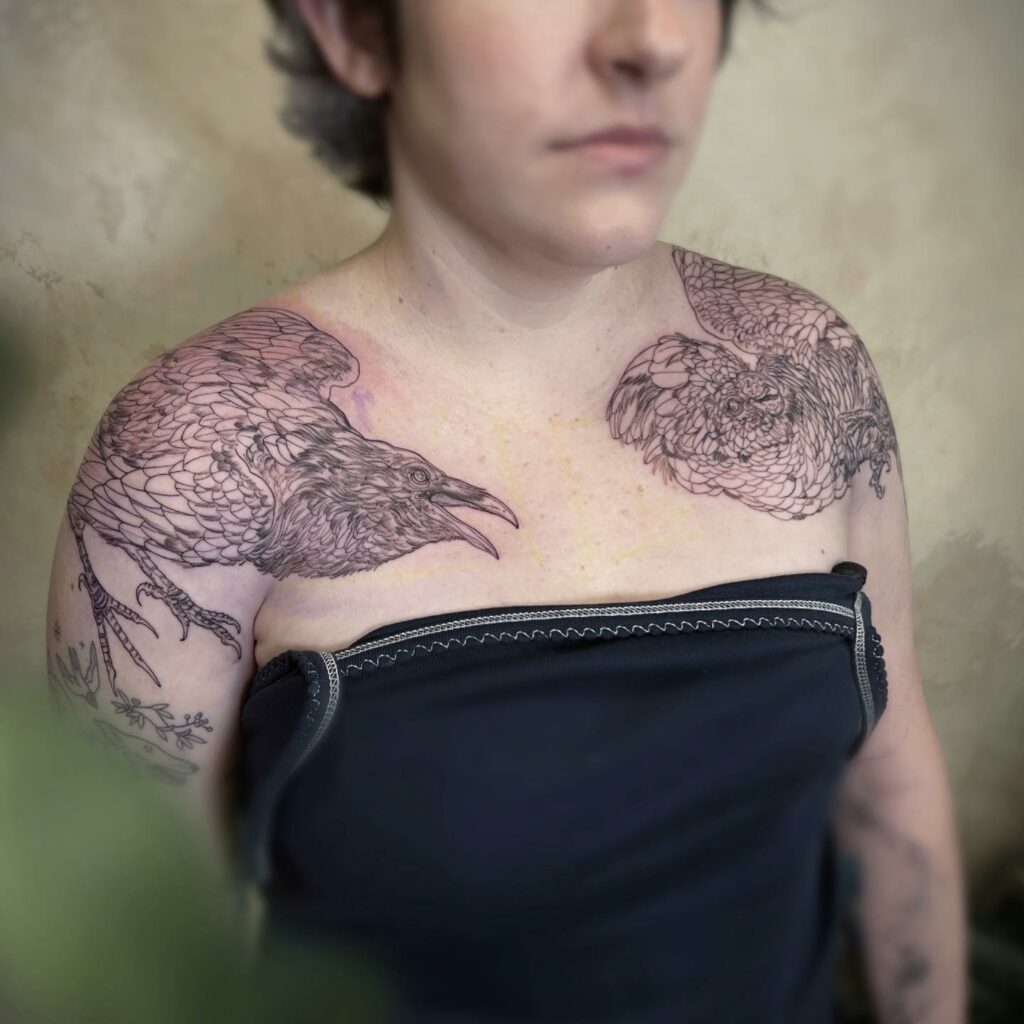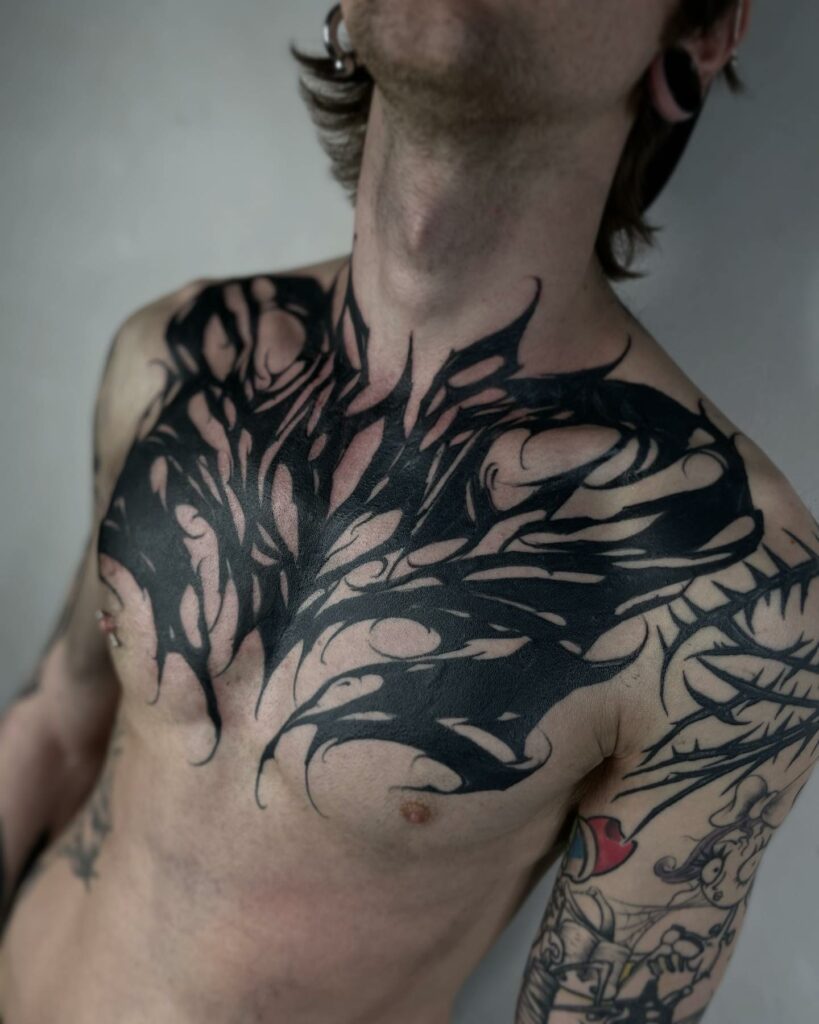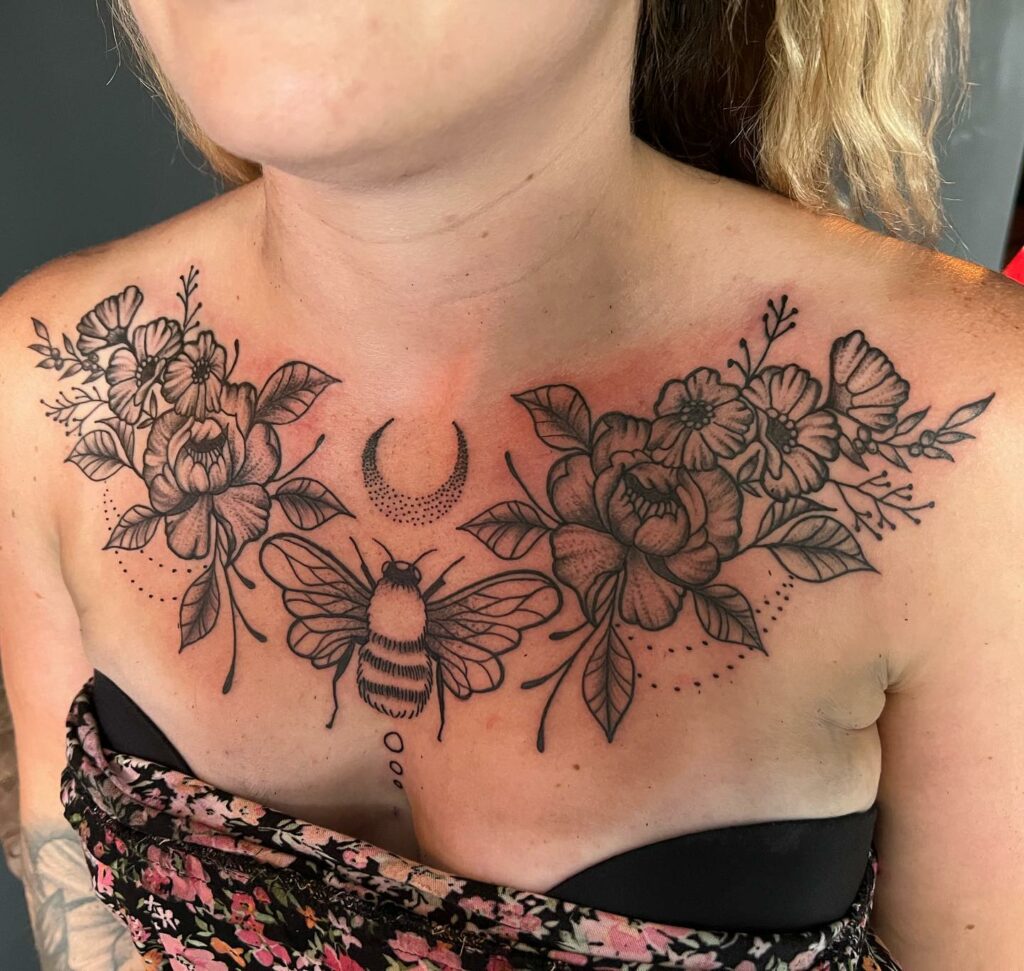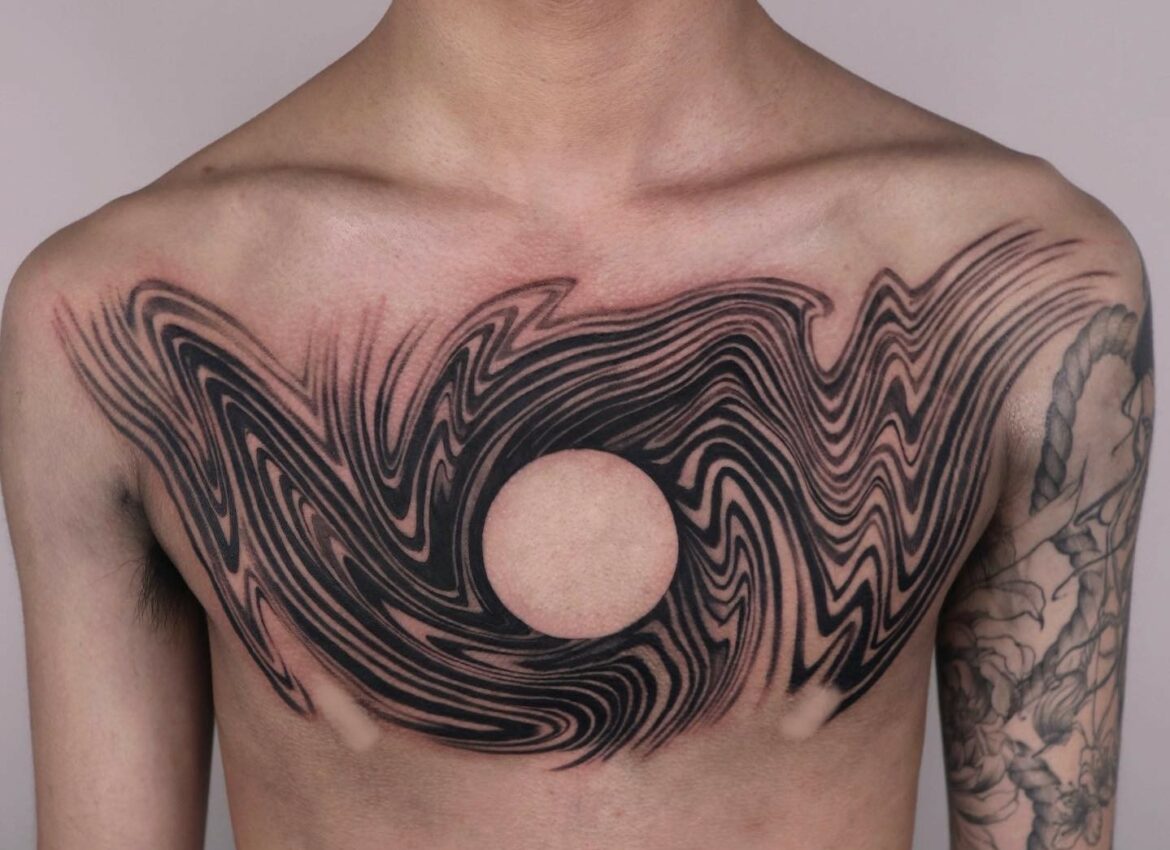Table of Contents
Today, we’re about to embark on a not-so-painful journey, a sort of ‘virtual tattoo,’ to answer the million-dollar question: How bad do chest tattoos hurt? Is it a tickle from a stray feather, or does it feel like you’ve tangled with a grizzly? Or perhaps somewhere in between? I promise no sugar-coating or tattoo fairy tales, just the cold, hard, inky truth.
In this post, we’ll delve into the intricate interplay of needles, skin, and pain receptors. We’ll explore the peculiarities of the chest area, including factors that can influence your experience. You’ll learn about the fascinating science behind the pain and, most importantly, how to handle it like a seasoned tattoo connoisseur.

Grab your curiosity and a sense of adventure, and remember, everyone’s journey to tattoo enlightenment is unique. Let’s dive into the ink-filled waters of tattoo lore and find out what it truly means to have your chest emblazoned with permanent art.
Chest Tattoos: From Rebellious to Mainstream

Chest tattoos, once the realm of seasoned ink lovers, have graduated to the mainstream. From whimsical whispers to audacious statements, these pieces have gained a loyal following. It’s the intimacy of this area that charms many — a private canvas that unfolds a deeply personal narrative. But, let’s be honest, even the simplest chest tattoos can pack a punch in the pain department. It’s like a never-ending rhythm of a drummer that doesn’t know when to quit. The chest ranks among the most painful areas to get inked, thanks to our bony friend underneath and the thin layer of padding.
Chest Tattoo Basics
I remember a client, a burly guy with tattoos peppered all over, bracing for a chest piece. He likened the experience to a therapeutic yet intense, relentless drumroll. For others, it’s a different ball game, resonating with an entirely new pain scale. It really boils down to your personal pain tolerance.

Why Do Chest Tattoos Hurt More?
The science behind chest tattoos being a touch more intense lies in the proximity to the ribcage and sternum. Thin skin plus less padding equals a more intimate encounter with the needle. Additionally, larger designs due to the expansive canvas may translate into prolonged sessions and sustained discomfort. As a general guide the table below shows the relative pain levels for different tattoo placements. Keep in mind that this is a general guide, as individual pain tolerance and body composition can significantly impact the experience.
| Tattoo Placement | Level of Pain (1 = least painful, 10 = most painful) |
|---|---|
| Wrist | 3 |
| Forearm | 3 |
| Upper arm/shoulder | 2 |
| Back | 4 |
| Lower back | 5 |
| Chest | 7 |
| Stomach | 8 |
| Ribcage | 9 |
| Foot | 10 |
| Ankle | 7 |
| Neck | 7 |
| Inner thigh | 6 |
| Knee | 9 |
| Elbow | 8 |
| Hand/Fingers | 8 |
What Can I Expect the Pain to Feel Like?
Your pain tolerance will ultimately guide your unique inked experience. Most describe it as a continuous, sharp tap dance across your chest, escalating when the needle flirts with the bone, resulting in a vibrating sensation that, while not necessarily painful, is definitely an odd feeling.

What You Can Do to Ease the Pain
- The Tattoo Apprentice Path: If you’re just stepping onto the tattoo trail, consider a modest design that won’t take long to execute. You can always expand on it later.
- The Importance of Rest: Make sure you’re well-rested before getting inked. A rested body can handle pain better. Booking a morning slot might be a wise choice.
- Steer Clear of Booze and Caffeine: A pre-tattoo pint or coffee might seem like a good idea, but they can thin your blood and lead to excessive bleeding. This won’t endanger your life, but it could disrupt the crisp outcome of your tattoo.
- Follow the Tattoo Guru’s Advice: After the inking, your artist will apply a soothing lotion and a protective covering. Listen to their wisdom and follow their aftercare advice to ensure proper healing and longevity of your tattoo.
Products You Can Buy To Ease The Pain
- Zensa Numbing Cream
- Pros: Contains the highest level of Lidocaine allowed for over-the-counter use, effective for many people, can be used for other skin procedures as well.
- Cons: Some people may not experience much numbing, can be expensive.
- Cost: Approximately $35-$45.
- Where to Buy: Amazon, Walgreens, the official Zensa website.
- Dr. Numb Topical Anesthetic Cream
- Pros: Contains 5% Lidocaine, water-based (which is less likely to affect the ink), long-lasting effect.
- Cons: Can be expensive, might not be effective for everyone.
- Cost: Approximately $50-$60.
- Where to Buy: Amazon, the official Dr. Numb website.
- Hush Anesthetic Gel
- Pros: Gel form for better absorption, can last up to 2 hours, designed specifically for tattoo pain.
- Cons: Requires application 1 hour prior to tattoo session, may not be as effective for people with high pain sensitivity.
- Cost: Approximately $25-$35.
- Where to Buy: Amazon, the official Hush Anesthetic website.
- UberNumb Topical Numbing Cream
- Pros: Contains 5% Lidocaine, long-lasting (up to 2 hours), non-oily, has Vitamin E to promote healing.
- Cons: Some users report it’s not as effective as other brands.
- Cost: Approximately $20-$30.
- Where to Buy: Amazon, the official UberNumb website.
Embrace Your Chest Tattoo

Yes, chest tattoos can be intense. But the personal connection, the ability to conceal or reveal at will, and the freedom in design selection make it a worthwhile journey. Plus, you’ll walk away with a beautiful piece of art etched on your skin. The key is preparation and a positive mindset. Embrace the pain; after all, it’s an integral part of this personal transformation. Remember, every stroke of the needle brings you closer to the masterpiece you envision. And when it’s over, you’ll realize it was all worth it. Trust me, I’ve been there, and so have many others!
What Are The Risk Associated With Chest Tattoo?
Getting a chest tattoo, much like any other tattoo, carries a certain degree of risk. While these are usually manageable with proper care and hygiene, it’s crucial to be aware of them to make an informed decision. Here are a few potential complications:
- Infection: This is one of the most common risks associated with any tattoo. Unclean equipment or poor aftercare can lead to bacterial infections, which can cause swelling, redness, pus, or a fever.
- Allergic Reactions: Some people may have allergic reactions to certain types of tattoo ink, especially colored ones. This can cause itching, skin irritation, or a rash.
- Scarring: If the tattoo needle goes too deep into the skin, or if the area doesn’t heal correctly, there’s a risk of developing keloids, which are raised scars.
- Skin Discoloration: Sometimes, a tattoo can lead to permanent skin discoloration. This is especially noticeable on chest tattoos since the skin on the chest is often lighter than other parts of the body.
- Interference with Medical Procedures: Chest tattoos can potentially interfere with certain medical procedures or tests like a mammogram, though such instances are rare.
- Difficulty in Tattooing: Due to the proximity to the bone, the chest area might be a difficult canvas for tattooing, potentially leading to less precise designs.
- Prolonged Healing: Chest tattoos often take longer to heal due to constant movement in the area from breathing.
Conclusion
As we wrap up this tattoo odyssey, let’s revisit some of the key takeaways. Chest tattoos can indeed be a test of resilience due to the area’s sensitivity and close proximity to the bone. However, this should not deter you from the pursuit of your personalized body art. Preparing adequately and taking steps to mitigate discomfort – from starting with smaller designs, getting ample rest, avoiding caffeine and alcohol, to using approved numbing creams – can make a world of difference in your inking experience. Always remember to adhere to your artist’s aftercare instructions for a vibrant, long-lasting tattoo. It’s crucial to note that everyone’s tattoo journey is unique, and pain perception varies widely. Yours might be a walk in the park or a heroic adventure. Either way, you’re transforming a part of your body into a canvas that tells your unique story. With each stride on this path, remember that you’re joining an ancient tradition of self-expression, and the temporary pain pales in comparison to the joy of your beautiful artwork. Let your chest tattoo journey be one of self-discovery and celebration of your individuality. And remember, as your trusted ink guide, I’m here to walk you through each step of this exciting journey.




